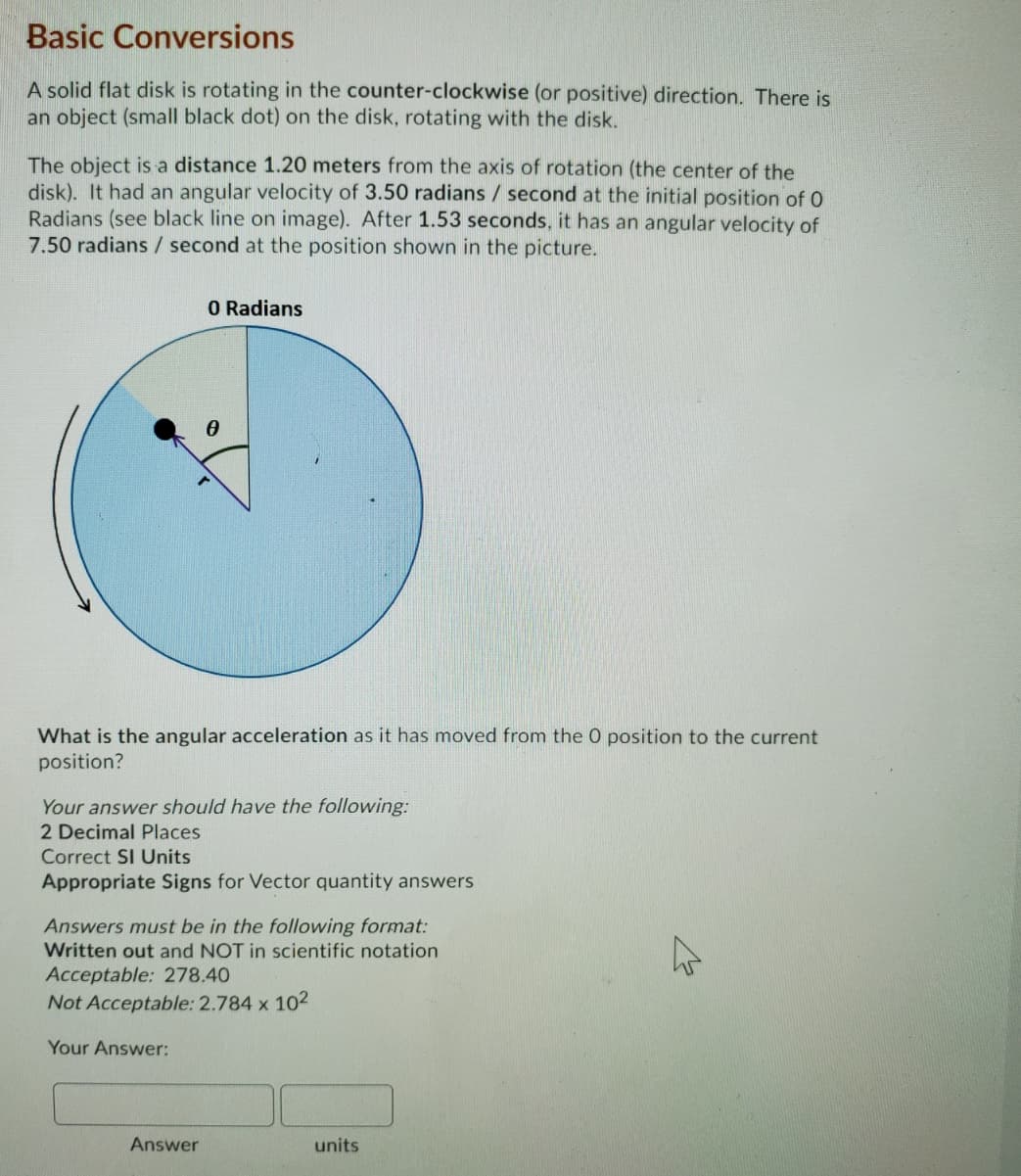A solid flat disk is rotating in the counter-clockwise (or positive) direction. There is an object (small black dot) on the disk, rotating with the disk. The object is a distance 1.20 meters from the axis of rotation (the center of the disk). It had an angular velocity of 3.50 radians / second at the initial position of 0 Radians (see black line on image). After 1.53 seconds, it has an angular velocity of 7.50 radians / second at the position shown in the picture.
A solid flat disk is rotating in the counter-clockwise (or positive) direction. There is an object (small black dot) on the disk, rotating with the disk. The object is a distance 1.20 meters from the axis of rotation (the center of the disk). It had an angular velocity of 3.50 radians / second at the initial position of 0 Radians (see black line on image). After 1.53 seconds, it has an angular velocity of 7.50 radians / second at the position shown in the picture.
Physics for Scientists and Engineers, Technology Update (No access codes included)
9th Edition
ISBN:9781305116399
Author:Raymond A. Serway, John W. Jewett
Publisher:Raymond A. Serway, John W. Jewett
Chapter10: Rotation Of A Rigid Object About A Fixed Axis
Section: Chapter Questions
Problem 10.2OQ: Consider an object on a rotating disk a distance r from its center, held in place on the disk by...
Related questions
Concept explainers
Angular speed, acceleration and displacement
Angular acceleration is defined as the rate of change in angular velocity with respect to time. It has both magnitude and direction. So, it is a vector quantity.
Angular Position
Before diving into angular position, one should understand the basics of position and its importance along with usage in day-to-day life. When one talks of position, it’s always relative with respect to some other object. For example, position of earth with respect to sun, position of school with respect to house, etc. Angular position is the rotational analogue of linear position.
Question
100%

Transcribed Image Text:Basic Conversions
A solid flat disk is rotating in the counter-clockwise (or positive) direction. There is
an object (small black dot) on the disk, rotating with the disk.
The object is a distance 1.20 meters from the axis of rotation (the center of the
disk). It had an angular velocity of 3.50 radians / second at the initial position of 0
Radians (see black line on image). After 1.53 seconds, it has an angular velocity of
7.50 radians / second at the position shown in the picture.
O Radians
What is the angular acceleration as it has moved from the 0 position to the current
position?
Your answer should have the following:
2 Decimal Places
rect SI Units
Appropriate Signs for Vector quantity answers
Answers must be in the following format:
Written out and NOT in scientific notation
Acceptable: 278.40
Not Acceptable: 2.784 x 102
Your Answer:
Answer
units
Expert Solution
This question has been solved!
Explore an expertly crafted, step-by-step solution for a thorough understanding of key concepts.
This is a popular solution!
Trending now
This is a popular solution!
Step by step
Solved in 2 steps

Knowledge Booster
Learn more about
Need a deep-dive on the concept behind this application? Look no further. Learn more about this topic, physics and related others by exploring similar questions and additional content below.Recommended textbooks for you

Physics for Scientists and Engineers, Technology …
Physics
ISBN:
9781305116399
Author:
Raymond A. Serway, John W. Jewett
Publisher:
Cengage Learning

University Physics Volume 1
Physics
ISBN:
9781938168277
Author:
William Moebs, Samuel J. Ling, Jeff Sanny
Publisher:
OpenStax - Rice University

College Physics
Physics
ISBN:
9781938168000
Author:
Paul Peter Urone, Roger Hinrichs
Publisher:
OpenStax College

Physics for Scientists and Engineers, Technology …
Physics
ISBN:
9781305116399
Author:
Raymond A. Serway, John W. Jewett
Publisher:
Cengage Learning

University Physics Volume 1
Physics
ISBN:
9781938168277
Author:
William Moebs, Samuel J. Ling, Jeff Sanny
Publisher:
OpenStax - Rice University

College Physics
Physics
ISBN:
9781938168000
Author:
Paul Peter Urone, Roger Hinrichs
Publisher:
OpenStax College

Physics for Scientists and Engineers: Foundations…
Physics
ISBN:
9781133939146
Author:
Katz, Debora M.
Publisher:
Cengage Learning

Glencoe Physics: Principles and Problems, Student…
Physics
ISBN:
9780078807213
Author:
Paul W. Zitzewitz
Publisher:
Glencoe/McGraw-Hill

Principles of Physics: A Calculus-Based Text
Physics
ISBN:
9781133104261
Author:
Raymond A. Serway, John W. Jewett
Publisher:
Cengage Learning